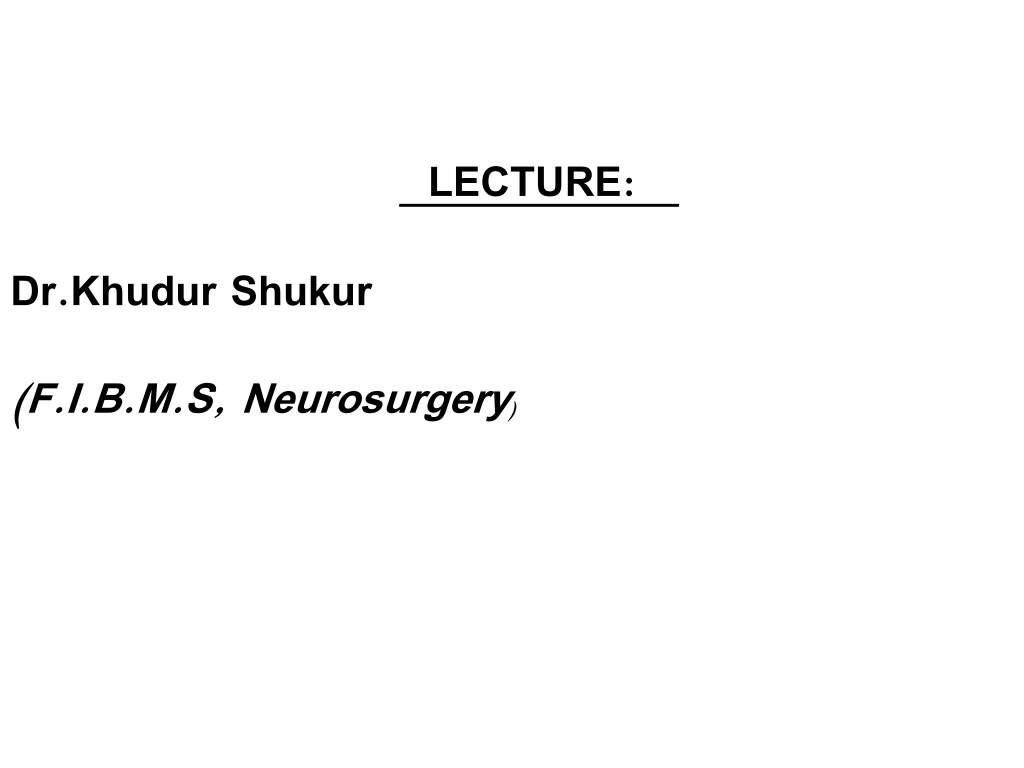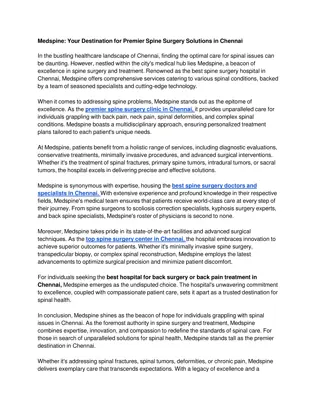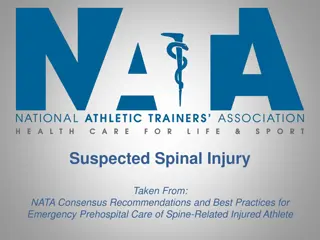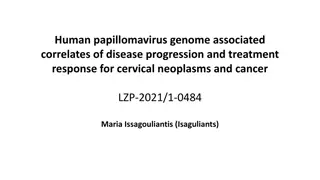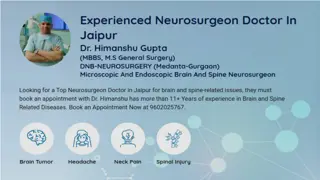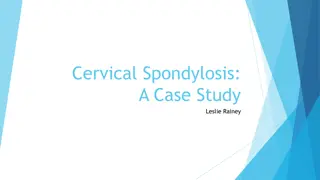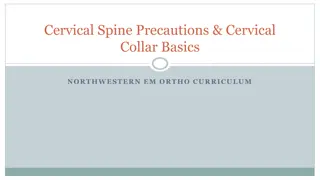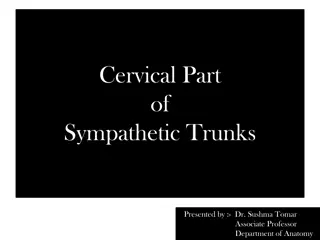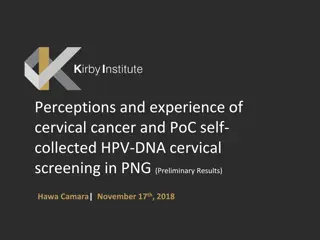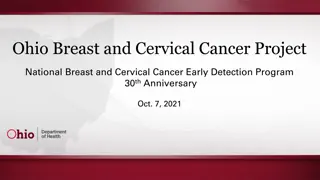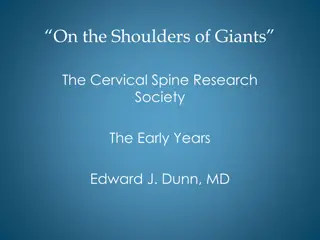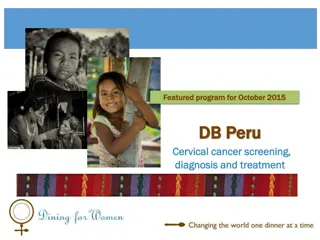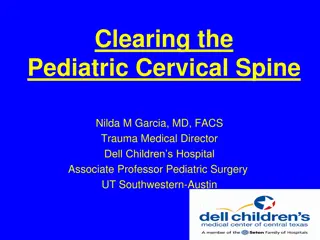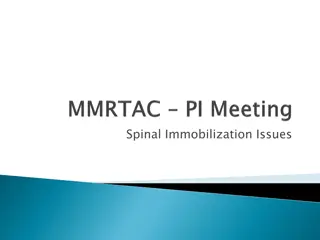Understanding Injuries to the Cervical and Thoracolumbar Spine
Cervical spine injuries are common, especially in the 15-30 age group, with motor vehicle accidents, falls, and sports being major causes. Male individuals are more prone to injuries. Neurological deficits are associated with specific types of injuries, necessitating prompt imaging for spinal cord injuries. Guidelines for imaging and evaluation of trauma patients are outlined, emphasizing the importance of a comprehensive assessment for proper diagnosis and management.
Download Presentation

Please find below an Image/Link to download the presentation.
The content on the website is provided AS IS for your information and personal use only. It may not be sold, licensed, or shared on other websites without obtaining consent from the author. Download presentation by click this link. If you encounter any issues during the download, it is possible that the publisher has removed the file from their server.
E N D
Presentation Transcript
LECTURE: Dr.Khudur Shukur (F.I.B.M.S, Neurosurgery)
Title: INJURES TO THE CERVICAL SPINE. THORACOLUMBAR SPINE FRACTURES.
INTRODUCTION: - Cervical spine is the most common site of spinal injuries. - It is the most mobile portion of the spine. -The most frequent age group to suffer an injury to spinal cord is 15-30 years -old. - Motor vehicle accidents , fall, and sports being the most common mechanisms of injures. - Male beings three times to four times injured than females. - Anatomic differences of pediatric spine: bone, ligament , and muscles must be considered.
INCIDENCE OF OF ADULT SPINE INJURIES: (cervical: 60%) (Thoracic: 8%) (Thoracolumbar: 20%) (Lumbar: 10%) (Sacral: 2%).
CERVICAL SPINE INJURIES AND NEUROLOGICAL DEFICIT: _ Atlanto-occipital dislocation:(100%) associated with neurological deficit. _ atlas :( 1-2%). _Axis :( 10%) _(C3- T1:6%) _ Unilateral cervical facet dislocation: (60 %) associated with neurological deficit. dislocation: (100%) associated with neurological deficit _ Bilateral cervical facet
IMAGING: 1- Any of the following patient should be treated as having spinal cord injuries (SCI)until proven otherwise: a- All victims of significant trauma. b- Trauma patients with loss of consciousness. c- Minor trauma victims with complaint referable to : - the spine (neck or back pain or tenderness) - the spinal cord (numbness or tingling in an extremity,weakenss). d- Associated findings suggestive of (SCI) include : - abdominal breathing . - priapism
2- Trauma patient who meet the following criteria donot require x-ray evaluation of the cervical spine : a- normal neurological examination and Glasco coma scale (GSC)of 15, with no delayed or inappropriate responses. b-not intoxicated. c-no neck pain or midline tenderness. d-no significant distraction injury.
3-It is important to include the whole cervical spine and T1 in the radiographic assessment. 4-simple cross table lateral is usually the first image of cervical spine . 5-with use of the (Anteroposterior,lateral,and open mouth odontoid )views the sensitivity of the series is 92% .
6-Areas identified as possible pathology on the plain radiographs should be further investigated with CT. 7-(10%) of patients with a cervical spine fracture have a second associated noncontiguous vertebral column fracture. 8-MRI:identify disc herniations, ligaments, softtissue,and spinal cord (especially in SCIWORA :SPINAL CORD INJURY WITHOUT RADIOGRAPHIC ABNORMALITY ).
MANAGEMENT 1-GENERAL PRINCIPLES - proper immobilization must be maintained until the presence (or absence) Of a spinal fracture or instability is determined. - the most common type of injuries are: fracture of the vertebrae of the cervical spine ,fracture subluxation, and isolated subluxation .
2-Atlanto-occipital dislocation -many patients dying of severe brainstem injury ,or respiratory arrest at the scene. -types :Anterior(type I),longitudinal(type II),and posterior (type III)dislocation . -do CT. -do (ORIF:open reduction and internal fixation)
3-Atlas fracture (C1) - Jefferson fracture ;a four-part ring fracture ,is the most frequent pattern of C1 fracture . -isolated anterior or posterior arch fractures can be effectively treated in Collar .lateral mass fractures can typically be manged in collar unless there Is significant comminution ,in which halo immobilization may be required For 8-12 weeks .
4-Axis fractures(C2) -account for (18%)of all cervical spine traumatic injuries . -(60%)of C2 fractures are odontoid Treatment: -rigid external immobilization . -or:ORIF -according to subtype. process fracture .
5-(C3-T1 injuries) - isolated C3 injuries are uncommon . - (75%)of all cervical spine fractures occur between C4 and T1 . - C5 is the most common site for cervical vertebral fracture . - the most common level of subluxation injuries is the C5-C6 interspace. - Fractures of the vertebral bodies are the most common type of injury to occur In the subaxil cervical spine. -principles of treatment: -early reduction and realignment. -in general ,anterior pathology is approached anteriorly and posterior Pathology is approached posteriorly. -indications of surgery include: - nonreducible spinal cord compression with deficit . - ligamentous injury with facet instability . - Kyphosis 15 degrees or more. - vertebral body compression 40 degrees or more .
6-Cervical spinal cord compression: a- complete lesion : No preservation of any motor and /or sensory function more than 3 segments below the level of injury .about 3% of patients with complete Injuries on initial exam will develop some recovery within 24 hours .Recovery Is essentially zero if the spinal cord remain complete beyond 72 hours. b-incomplete lesion Any residual motor or sensory function more than 3 segment below Level of the injury . look for signs of preserved long- tract function : @signs of incomplete lesion: -sensation (including position sense ) -or voluntary movement in the lower extremities. @types of incomplete lesion -central cord syndrome -Brown sequard syndrome. -anterior cord syndrome . -posterior cord syndrome
THORACOLUMBAR SPINE FRACTURES. Thoracolumbar junction being the second most common location for injury behind the cervical spine . BIOMECHANICS The thoracolumbar junction is a zone of structural and functional transition, which makes it vulnerable to injury. -transfer energy from thoracic spine (rigid) to the lumbar spine (relatively mobile). (75%) of fractures occurring between (T12-and L2).
RISK OF NEUROLOGICAL INJURY -injuries to the spinal column at or above T12 (above the conus )are associated with higher risk of complete cord injuries , whereas incomplete deficits are more common below L1 (at cuda equina). CLINICAL EVALUATION -inspection and palpation of the back (widening, step-offs, echymosis). -Neurological examination :(conus medullaris ,cauda equina ):may find mixed upper and lower motor neuron signs. -sacral sparing :-preserved perianal sensation -voluntary anal contraction -in the setting of a neurological deficit (complete) -indicate incomplete spinal cord injury
RADIOGRAPHIC EXAMINATION 1- AP -LATERAL plain x-ray :diagnosing compression of the vertebral body and fractures of the transverse and spinous process . 2- CT: occult injury, and reconstruction (sagittal and coronal) 3- MRI:soft tissue, disc.
CLASSIFICATION OF THORACOLUMBAR FRACTURES **classification schemes are designed to :( 1) relate mechanism of injury with fracture pattern (2) provide a template for clinical research, and (3) guide treatment. **the modified comprehensive classification (AO/ASIF)is currently the most utilized classification system :it divides fractures in to three main types : -Type (A) compression -Type (B) distraction -Type(C) multidirectional **It ranks fracture according to severity **There is increased risk of instability and neurological insult as one progress from type A to type C fractures and each type is subdivided based on severity of injury.
FRACTURE MANAGEMENT @ Factors that determine optimal treatment are: -neurological injury, degree of canal compression, potential for instability based on fracture pattern, and the individual patient compliance with different treatment. @ Surgical intervention is often advocated for the following reasons : 1-decompress the neural elements in case of neurological deficit . 2-prevent possible late neurological injury in unstable fractures. 3-correct and prevent kyphotic deformity that could result in back pain. 4-allow for early mobilization avoiding the complications prolonged bed rest. @ Early decompression is almost uniformly advocated in patients with incomplete neurological injuries and canal compromised. @ In patients with complete neurological injuries or IN neurologically intact patients, surgery may be delayed to allow time to consider overall clinical picture. @ Treatment options include: activity restriction, bracing, and surgical intervention. @ Anterior ,posterior ,and combined approaches for surgical decompression and stabilization are available . .. End
